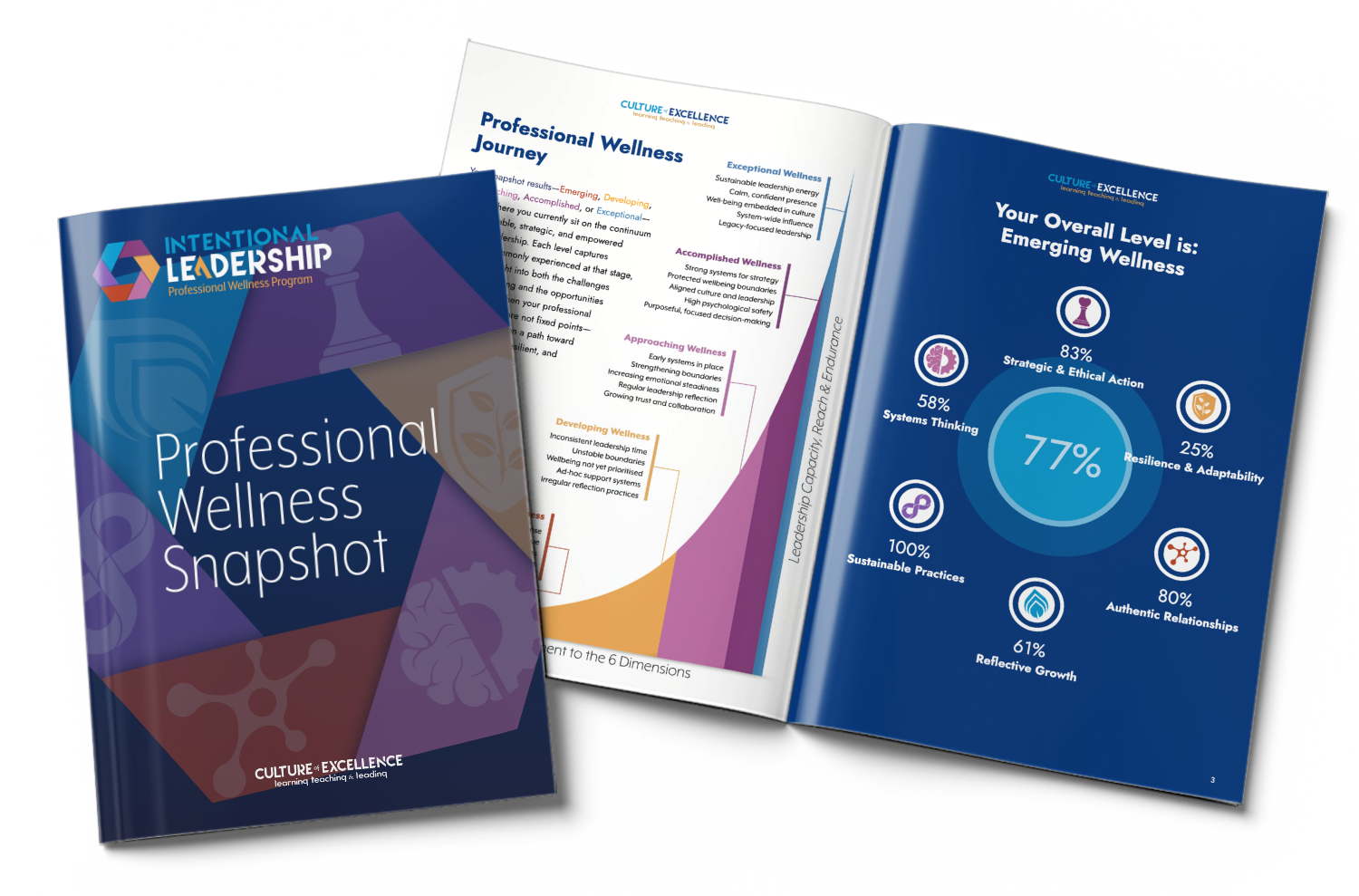
Shackled Authority
All of the responsibility, none of the power
This video explores one of the most frustrating patterns in modern school leadership: the expectation to lead without the power to decide. From micromanaged systems to overburdened approval chains, leaders are being asked to transform schools from inside a straightjacket. This isn’t sustainable—and it’s not leadership.
What part of your leadership are you expected to act on—but not truly empowered to influence?
Want to Lead With Steadiness—Not Strain?
Join our FREE Professional Wellness Workshop—a live session where we explore all six dimensions and help you refocus on what really sustains school leadership.

Shackled Authority
All of the responsibility, none of the power
The title says “leader.” The inbox says “everything is your problem.” But the system? It quietly says: “Stay inside the lines.”
It’s the most frustrating paradox I see in school leadership: You’re accountable for the outcomes— but disempowered to change the inputs. This isn’t laziness either, and it’s not a lack of vision. It’s what I call Shackled Authority—and it’s slowly eroding leadership from the inside out.
The illusion of control
In coaching conversations, I hear this all the time:
- “I’m trusted with performance—but not with decisions.”
- “I’m held to outcomes I don’t fully control.”
- “Every initiative has to go through six layers—and by the time it’s approved, it’s no longer mine.”
This echoes what I unpacked in The Trust Dilemma, where staff grow quiet not out of contentment—but out of self-protection. And in The Emotional Tsunami, I explored how leaders often absorb the stress of everyone around them—without being given space to process their own. Shackled authority is the leadership version of that silence. Not refusal, not rebellion—just quiet erosion.
Let’s explore three truths I’ve seen help leaders navigate this space with clarity and strength—even when systems feel immovable.
Truth 1: Accountability without autonomy creates quiet collapse
A principal I worked with was externally praised as high-performing.
- Student achievement was steady
- Community confidence was high
- Compliance documents were pristine
But in coaching, she confessed: “I’m managing expectations, not leading change. Every creative idea gets neutered or delayed—and eventually I stopped suggesting them.”
This is role conflict at its core. Kahn et al. (1964) first defined it as the psychological strain that results from being expected to achieve outcomes without the necessary authority or support. It leads to chronic stress, decision fatigue, and eventual disengagement.
People don’t leave leadership because it’s hard. They leave because it becomes hollow.
Modern leadership research confirms this. According to Ingersoll and Merrill (2017), the top reason school leaders cite for considering resignation is not workload—it’s lack of decision-making power relative to accountability pressure.
What helps?
Start with these three questions:
- Where do I still have full agency?
- What micro-decisions can I make that reflect my actual values?
- How can I make that visible to my team?
Even small, reclaimed decisions can reignite a sense of purpose—and model autonomy under pressure. As I explored in Are You Measuring What Really Matters?, leadership is often about sensing cultural momentum before it shows up in the metrics.
Truth 2: Shackled authority leads to performative leadership
In another school, a deputy had just launched a new initiative—full of structure, alignment, and branding. But privately, he told me, “This isn’t what we need. It’s what I was allowed to do.” He wasn’t disengaged; he was exhausted from pretending. This is performative leadership—when leaders are forced to simulate progress to maintain credibility, rather than act on what they know is needed. When strategy becomes a staged process, leaders stop making meaningful decisions and start managing impressions (Grint, 2005).
And as Edmondson (2019) points out, in cultures where psychological safety is low, leaders tend to default to risk-averse behaviour—not because they lack ideas, but because they sense the cost of non-conformity is too high. Performance becomes a shield— a way to avoid consequences in a system that punishes real leadership.
How do we return to presence?
- Name one uncertainty in your next team meeting
- Share what you wish you could do—and ask others what they would do
- Open a single leadership conversation that’s not tied to KPIs
Authenticity doesn’t require breaking the rules. It just means choosing to speak into the space between them.
Truth 3: Influence is built from clarity—not control
One school leader I supported had stopped trying to fight the system at the top. Instead, she began focusing on her “zone of presence”:
- 1:1s with staff that weren’t tied to performance goals
- Protecting time for trust-based dialogue
- Building microcultures of autonomy and trust
“I couldn’t shift the whole system,” she told me, “but I could change the temperature of the room I was in.”
This is what Senge (2006) calls a leverage point: a space in the system where small, intentional actions create disproportionate positive effects. Rather than chasing control, effective leaders shift their focus to clarity:
- What matters most right now?
- Where is trust already present—and how can I build from it?
- What feedback loops are missing—and how can I start them myself?
You may not have power over the whole system, but you still shape the experience inside it. Leadership doesn’t disappear when constraints tighten—it just shifts closer to the people.
If you're leading without leverage, you're not failing
You’re operating in a system that’s over-indexed on accountability and under-invested in agency. That’s not your fault, but it is your environment.
Real leadership begins not with control, but with clarity. Not with permission, but with presence. Your staff aren’t waiting for you to overhaul the system—they’re watching for how you show up inside it.
What you say. What you protect. What you model.
In rigid systems, presence becomes radical. And clarity becomes its own kind of power.
What’s one decision you should be empowered to make—but aren’t?
References
Edmondson, A. C. (2019). The fearless organization: Creating psychological safety in the workplace for learning, innovation, and growth. Wiley.
Grint, K. (2005). Leadership: Limits and possibilities. Palgrave Macmillan.
Ingersoll, R., & Merrill, L. (2017). A quarter century of changes in the elementary and secondary teaching force: From 1987 to 2012. National Center for Education Statistics.
Kahn, R. L., Wolfe, D. M., Quinn, R. P., Snoek, J. D., & Rosenthal, R. A. (1964). Organizational stress: Studies in role conflict and ambiguity. Wiley.
Maslach, C., & Leiter, M. P. (2016). Burnout: A multidimensional perspective. In R. J. Burke & C. L. Cooper (Eds.), The fulfilling workplace (pp. 77–96). Routledge.
Senge, P. M. (2006). The fifth discipline: The art and practice of the learning organization (Rev. ed.). Doubleday.

Not Sure What's Holding You Back?
Take our quick 2-minute Professional Wellness Snapshot to pinpoint where your biggest barrier lies—and which leadership dimension to strengthen next.